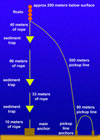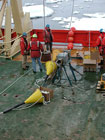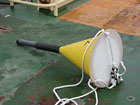12/19/01 0030 hrs.
64 57 S
63 23 W
Flanders Bay near the Bismark Strait
Clear overhead, some clouds on the mountains
light winds, -1 C
We never did get our blue sky yesterday. The clouds settled back in and most of the day was a bright overcast.
Around 10 a.m. 12/18 an area was chosen to put in a sediment trap mooring and the balance of the morning was spent getting it in the water. Dr. Bob Gilbert of Queen's University in Kingston Ontario, Canada, designed the mooring and was in charge of its deployment. Working with the ship's Marine Science Tech's (MSTs) deployment went smoothly. Deploying an array of floats, sediment traps and rope totalling over 200 meters in length (around twice the length of a football field) along with a 400 pound anchor weight is quite the process.

Illustration of the sediment trap mooring deployed in Gerlache Strait on 12/18. Illustration is not to scale. (Click image for larger version.)
The illustration shows all the components of the sediment trap as it should be on the bottom in 427 meters of water. This is how it is all put in. With the ship a ways away from the desired station the components are streamed off the stern of the ship starting with the floats, the rope between the floats and the first trap, then the upper most trap, the next set of rope, the middle trap, more rope and the lowest trap. The anchor weight, hanging from a crane cable is positioned at the water surface. At this point the anchor is hanging at the water line from the crane and floating behind the ship are all the components of the mooring. A quick release is used to connect the anchor weight to the crane cable. As the ship passes over the selected spot the quick release is released and the anchor weight sinks rapidly pulling down the mooring. This spot is carefully noted on the GPS. The ship continues on its course and the pickup line continues to spool out. After all 500 meters of pickup line are out the first of the pickup line anchor weights are released and 90 meters of line later the second one goes in.
While working on this illustration I looked out the window to see a 35-40 foot sailboat beside us. Not what you expect to see at 3:30 in the morning in the Bismark Strait.

35-40 foot sailboat off the starboard side of the NBP while traveling to Palmer Station through the Bismark Strait @ 3: 30 am 12/19. Sailboat headed northeast up the Neumayer Channel a short time later. (Click image for larger version.)

Components of the sediment trap mooring on the rear deck of the ship. Floats hang on the stern safety rail and the traps and ropes are strung out toward the camera. (Click image for larger version.)
Here is what the entire mooring looks like on deck before deployment. The floats are hanging on stern safety rail, the three individual traps are lined up on the deck with the lengths of rope between the traps in boxes. The main anchor weight is on the deck between the three MSTs with a white rope and the crane cable attached to it. The 500 and 90 meters of pickup line are in the boxes near the stern safety rail on the right side of the picture. The pickup line anchors are not visible.

An individual sediment trap. Grid on the top opening keeps out large material so only fine material descending through the water column enters the trap. Sediment is concentrated by the large surface area of the funnel into the grey tube at the base. Traps will be left in place for one year and recovered sometime next austral summer. (Click image for larger version.)
This photo shows one of the sediment traps in detail. Sediment falling through the water column enters the trap through the grating on the top. This grate is designed to keep large objects out of the traps. Sediment settles down the large funnel and accumulates in the grey tube at the bottom. The large diameter of the funnel concentrates the amount of sediment accumulated so the mooring can be left in for only one year and still collect a large amount of sediment. The shallowest part of the mooring, the floats, are kept 200 meters below the surface to avoid having them catch on the submerged portion of a passing iceberg and have the mooring dragged from its known location.
Plans call for us to stop at Palmer Station this morning.
Cheers,
Dave
Posted December 19, 2001
